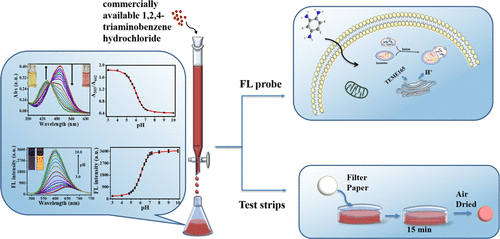当前位置:
X-MOL 学术
›
ACS Appl. Bio Mater.
›
论文详情
Our official English website, www.x-mol.net, welcomes your
feedback! (Note: you will need to create a separate account there.)
1,2,4-Triaminobenzene as a Fluorescent Probe for Intracellular pH Imaging and Point-of-Care Ammonia Sensing
ACS Applied Bio Materials ( IF 4.6 ) Pub Date : 2021-07-12 , DOI: 10.1021/acsabm.1c00404 Shuangting Yang 1, 2 , Yuanjin Zhan 1 , Wen Shou 1, 2 , Lifen Chen 2 , Zhenyu Lin 1 , Longhua Guo 2
ACS Applied Bio Materials ( IF 4.6 ) Pub Date : 2021-07-12 , DOI: 10.1021/acsabm.1c00404 Shuangting Yang 1, 2 , Yuanjin Zhan 1 , Wen Shou 1, 2 , Lifen Chen 2 , Zhenyu Lin 1 , Longhua Guo 2
Affiliation

|
As one of the health indicators, intracellular pH plays important roles in many processes of cell functions. Abnormal pH changes would result in the occurrence of inflammation, cancer, and other diseases. Thus, it is of significant importance to develop effective techniques for sensitive detection of pH changes for the clinical diagnosis of various diseases related to cells. In this paper, 1,2,4-triaminobenzene hydrochloride was explored as an organic molecular fluorescent probe for sensitive and selective detection of intracellular pH changes for the first time. Due to the protonation and deprotonation of amino groups of the probe, its fluorescent intensity at 599 nm or the ratio of absorbance at 505 and 442 nm has a good linear relationship with pH values in the range of 5.0–7.0. Benefiting from the excellent physical and chemical properties of 1,2,4-triaminobenzene hydrochloride, the fluorescent probe has good water solubility, low toxicity, high photostability, great reversibility, good cell penetration, fast response speed, and so on. As a proof-of-concept demonstration, the proposed probe is employed for the fluorescence imaging of cells and mouse tissue sections with satisfactory performance in pH differentiation. Additionally, the probe was successfully employed to prepare test strips as a kind of point-of-care testing device to detect ammonia, which showed great potential in practical applications.
中文翻译:

1,2,4-三氨基苯作为荧光探针用于细胞内 pH 成像和床旁氨传感
作为健康指标之一,细胞内pH在细胞功能的许多过程中发挥着重要作用。pH值的异常变化会导致炎症、癌症和其他疾病的发生。因此,开发灵敏检测pH变化的有效技术对于临床诊断与细胞相关的各种疾病具有重要意义。本文首次探索了1,2,4-三氨基苯盐酸盐作为一种有机分子荧光探针,用于灵敏、选择性地检测细胞内pH值的变化。由于探针氨基的质子化和去质子化,其在599 nm处的荧光强度或在505和442 nm处的吸光度比值在5.0-7.0范围内与pH值具有良好的线性关系。得益于1,2,4-三氨基苯盐酸盐优异的理化性质,该荧光探针具有水溶性好、毒性低、光稳定性高、可逆性好、细胞穿透性好、响应速度快等优点。作为概念验证演示,所提出的探针用于细胞和小鼠组织切片的荧光成像,在 pH 分化方面具有令人满意的性能。此外,该探针成功用于制备试纸条,作为一种即时检测氨的检测装置,在实际应用中显示出巨大的潜力。作为概念验证演示,所提出的探针用于细胞和小鼠组织切片的荧光成像,在 pH 分化方面具有令人满意的性能。此外,该探针成功用于制备试纸条,作为一种即时检测氨的检测装置,在实际应用中显示出巨大的潜力。作为概念验证演示,所提出的探针用于细胞和小鼠组织切片的荧光成像,在 pH 分化方面具有令人满意的性能。此外,该探针成功用于制备试纸条,作为一种即时检测氨的检测装置,在实际应用中显示出巨大的潜力。
更新日期:2021-08-16
中文翻译:

1,2,4-三氨基苯作为荧光探针用于细胞内 pH 成像和床旁氨传感
作为健康指标之一,细胞内pH在细胞功能的许多过程中发挥着重要作用。pH值的异常变化会导致炎症、癌症和其他疾病的发生。因此,开发灵敏检测pH变化的有效技术对于临床诊断与细胞相关的各种疾病具有重要意义。本文首次探索了1,2,4-三氨基苯盐酸盐作为一种有机分子荧光探针,用于灵敏、选择性地检测细胞内pH值的变化。由于探针氨基的质子化和去质子化,其在599 nm处的荧光强度或在505和442 nm处的吸光度比值在5.0-7.0范围内与pH值具有良好的线性关系。得益于1,2,4-三氨基苯盐酸盐优异的理化性质,该荧光探针具有水溶性好、毒性低、光稳定性高、可逆性好、细胞穿透性好、响应速度快等优点。作为概念验证演示,所提出的探针用于细胞和小鼠组织切片的荧光成像,在 pH 分化方面具有令人满意的性能。此外,该探针成功用于制备试纸条,作为一种即时检测氨的检测装置,在实际应用中显示出巨大的潜力。作为概念验证演示,所提出的探针用于细胞和小鼠组织切片的荧光成像,在 pH 分化方面具有令人满意的性能。此外,该探针成功用于制备试纸条,作为一种即时检测氨的检测装置,在实际应用中显示出巨大的潜力。作为概念验证演示,所提出的探针用于细胞和小鼠组织切片的荧光成像,在 pH 分化方面具有令人满意的性能。此外,该探针成功用于制备试纸条,作为一种即时检测氨的检测装置,在实际应用中显示出巨大的潜力。































 京公网安备 11010802027423号
京公网安备 11010802027423号